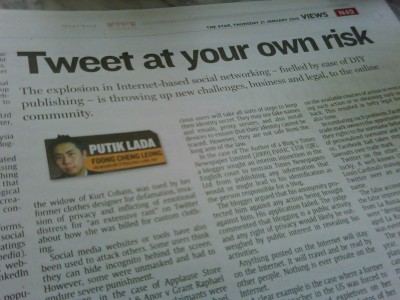Couple of weeks ago, fellow blogger Su Ann of Quaintly.net told me that her boyfriend read my blog when he was still an aspiring lawyer. I was rather surprise as I’ve neglected this space for some time. Anyway, Hi! Su Ann’s bf if you’re reading this.
The conversation hit some distant memories of mine. Throughout my 7 years of practice, I had many lawyers coming up to me telling me that they read my blog when they were still in university. I’m glad that I’ve been a source of entertainment for them over these years.
With that, I’ll leave some tips and trick on legal practice in some of my future postings for the benefit of fellow lawyers and aspiring lawyers.
In September 2012, I spoke at the International Malaysian Law Conference (IMLC). The IMLC traces it roots back to 1973 when it was known as the Malaysian Law Conference. This 3 days event broke the conventional by welcoming the participation of the general public, and especially entrepreneurs and role players. Throughout this three (3) days event, numerous sessions with interesting topics are held for the benefit of participants. Prime Minister Najib Razak officiated the event.
My topic was “Social Media: Damned if you do, damned if you don’t”. The other speakers were from a local large firm, a large Singaporean firm and a Queen’s Counsel. I was the small kucirat within these senior practitioners. It was daunting especially when I am the youngest and I no longer have a large firm to back me up.
Part of the crowd. I think the hall was too big for the crowd
I wanted to speak on s. 114A of the Evidence Act 1950 but I found out that there was another session covering the same topic. Few days before the event, I suddenly thought of the topic Malaysian social media disasters. I asked a question on Twitter and Facebook for feedback on Malaysia’s worst social media disasters and I had numerous feedback. I managed to compile a presentation slide within a few hours.
Me on the far right checking out the tweets about the event. Twitterjaya was not kind to speakers who bore them.
The speaker before me, Alex Charlton QC, had a very soothing voice to mesmerise the crowd. Some say it was sexy. With a voice like his, any boring presentation will be interesting.
When it came to my turn, I started my speech with, “I don’t have a sexy voice…”.
My presentation went well. I guess the participants enjoyed it as they were laughing loudly to some of the contents of my presentation. My presentation had expletives such as the F word and B word. I’m not sure whether I am the first person to have such words presented in the IMLC. You can download the slides at my blawg.
After the talk, Lim Chee Wee, President of the Malaysian Bar, introduced me to Tony Fernandes, founder CEO of AirAsia. He was scheduled to speak after our session. He reached out for my hands and he asked for my name again. I got to shake his hands!
I didn’t wash it for a week hoping that my blessed hands will make the billions that Tony does with his hands.
Tony gave a very inspiring speech on how he started AirAsia. It was a story about an ordinary Indian chap with a big vision who took all steps that were seen to be impossible. He worked overseas for many years and returned to Malaysia after he couldn’t get along with his new boss. After months of hanging about, he suddenly had a vision of starting an airline. All he had was RM500,000 and a friend with another RM500,000. With that amount, he pulled all sorts of strings to get things done.
Perhaps one interesting part of the story is that he offered his lawyer some shares in AirAsia in return of the lawyer’s legal fees. Unfortunately, the lawyer rejected Tony’s proposal. The shares are worth millions today!
Token of appreciation from the Bar. I don’t know what to do with this since I now run a paperless office.
You can read a report on Tony’s speech here.
After Tony’s presentation, I was interviewed by Bernama. It was done entirely in Malay (!!!). I think it went so bad that they decided not to mentioned it in any of their news. But I got a short mention in The Star newspaper.
If you wonder how I go a spot to speak, it was fairly easy. I sit in the Intellectual Property Committee as a member. Committees in the Bar Council are usually the main source of referral for the Bar to source for speakers for their events. Everyone is free to join the committees.
Most of the Committees organise talks for members to, among others, educate members on certain topics and discuss current issues. This leaves many speaking opportunities for committee members. Since I speak and write a lot on social media laws, I naturally get chosen to speak about social media. There you go, a little tip on how to get speaking opportunities.
